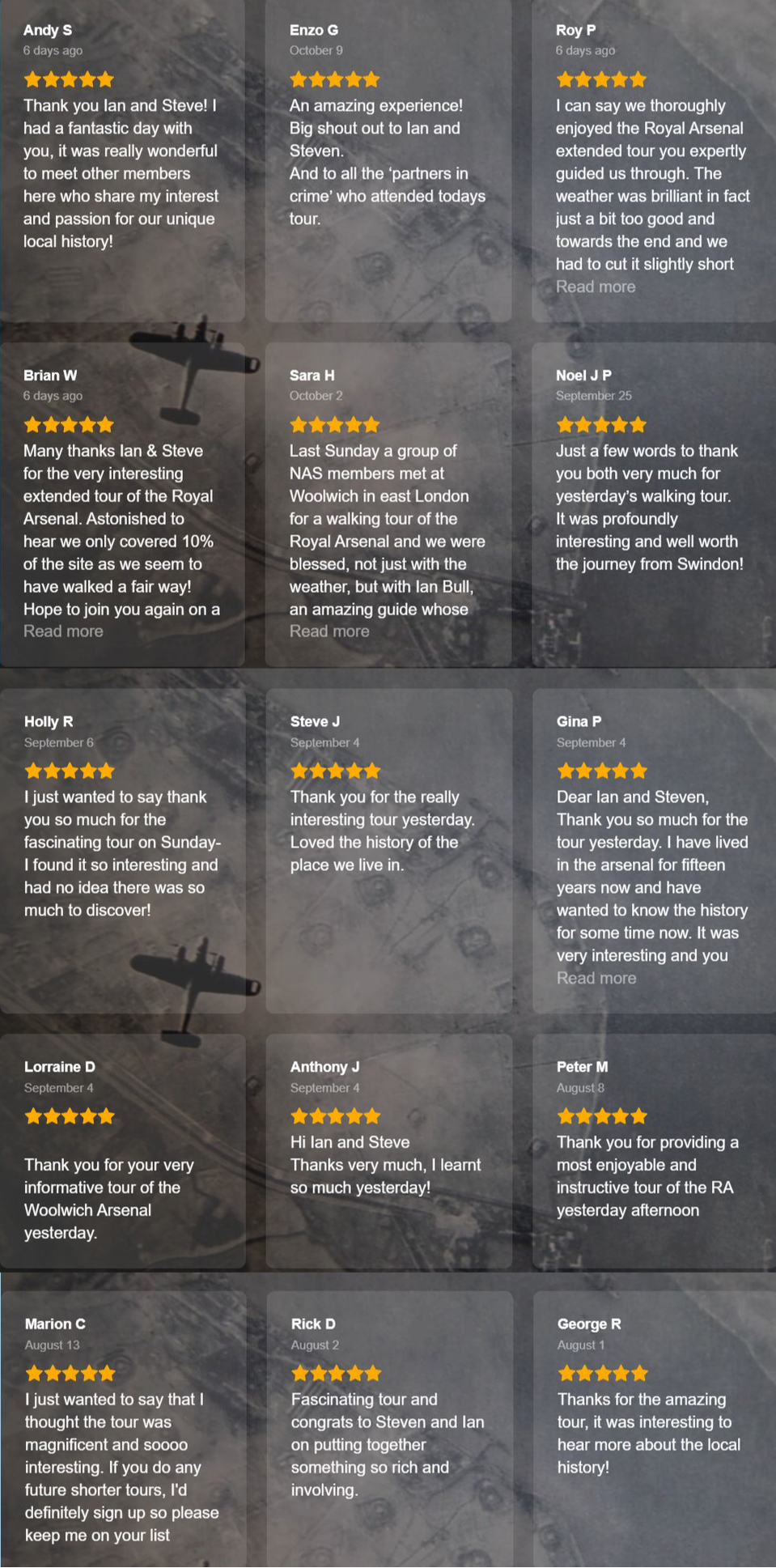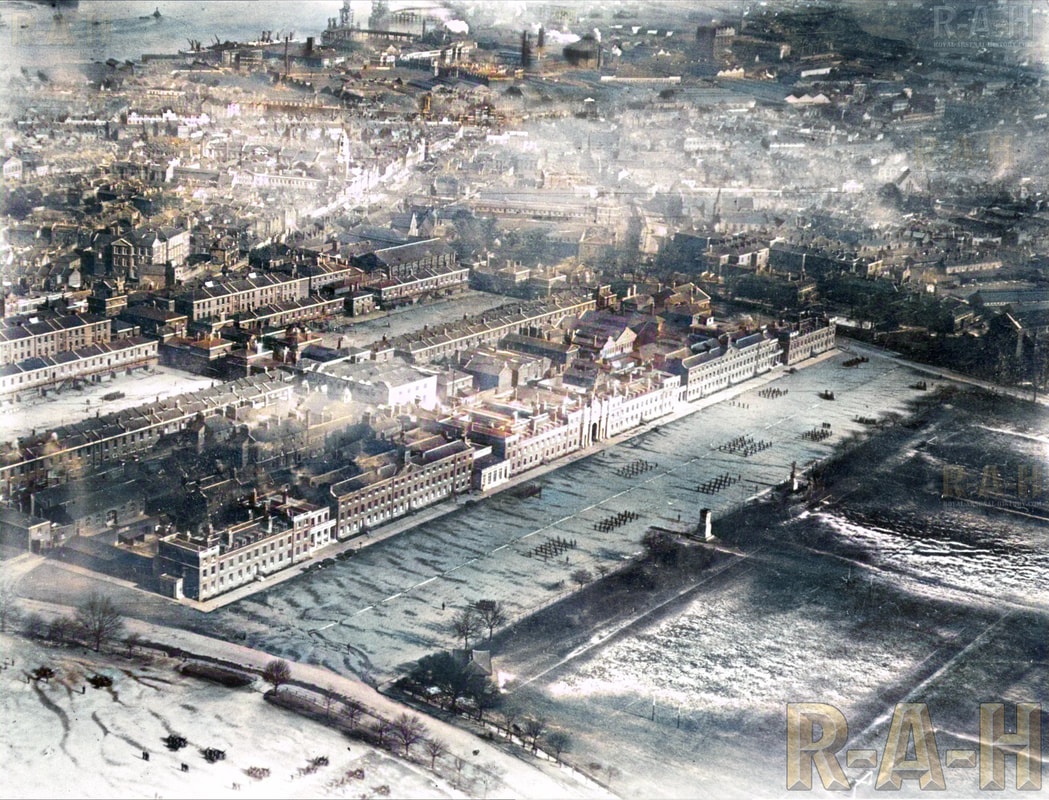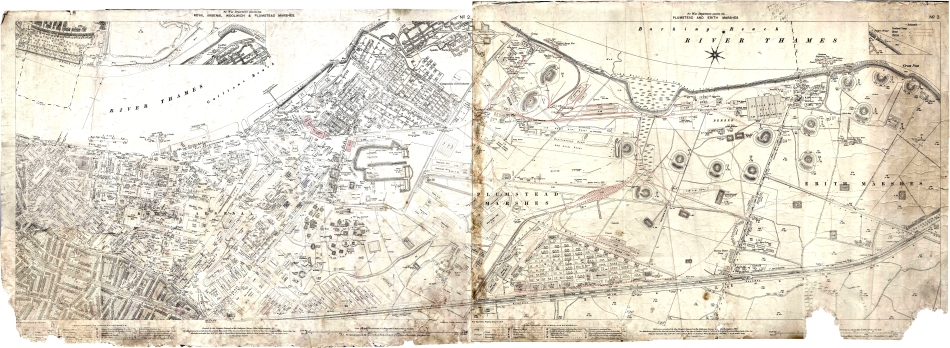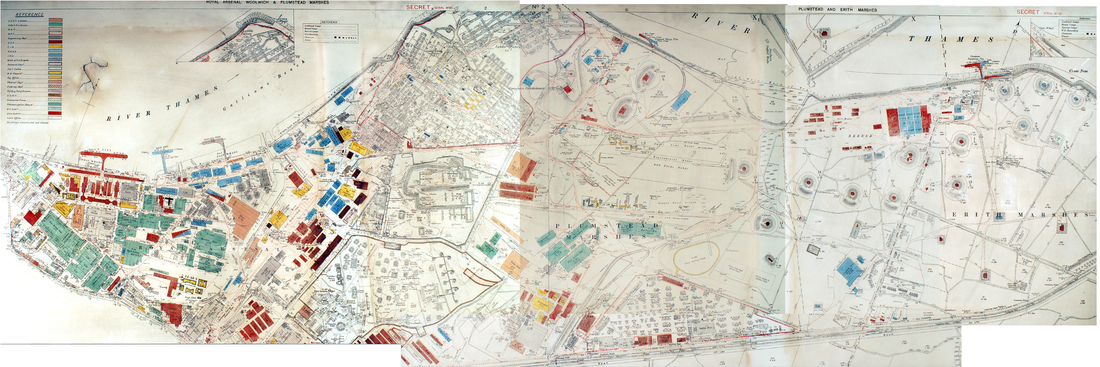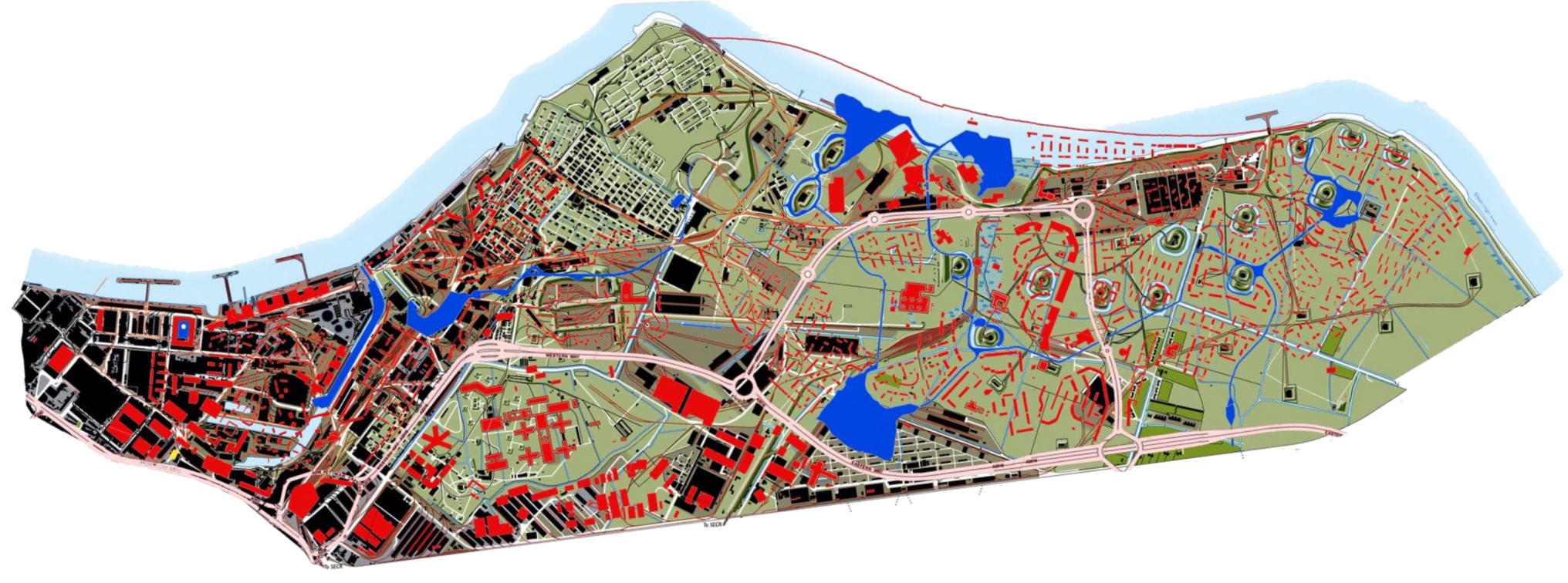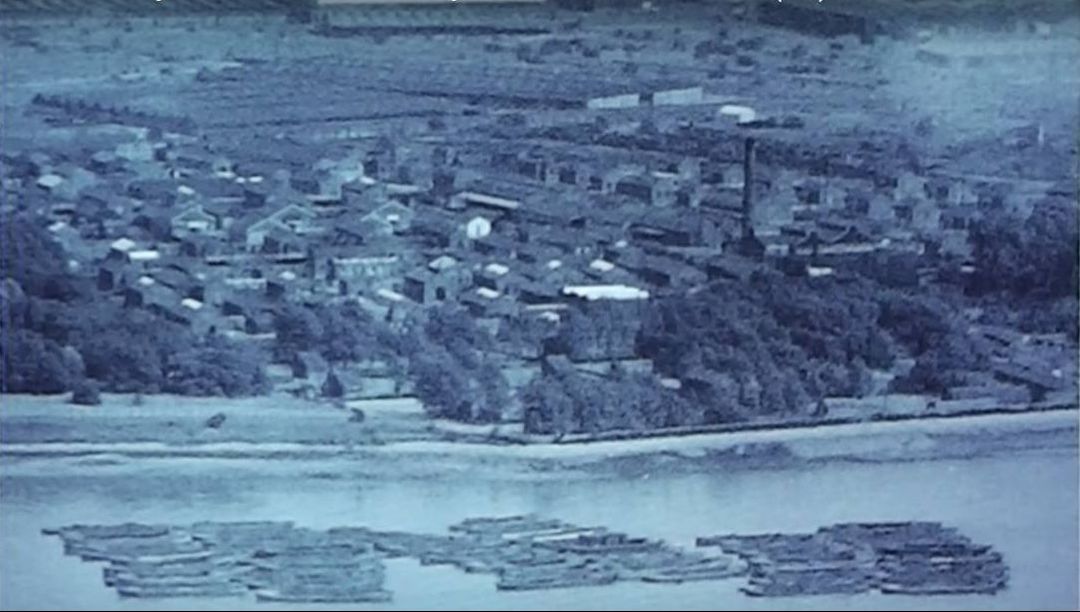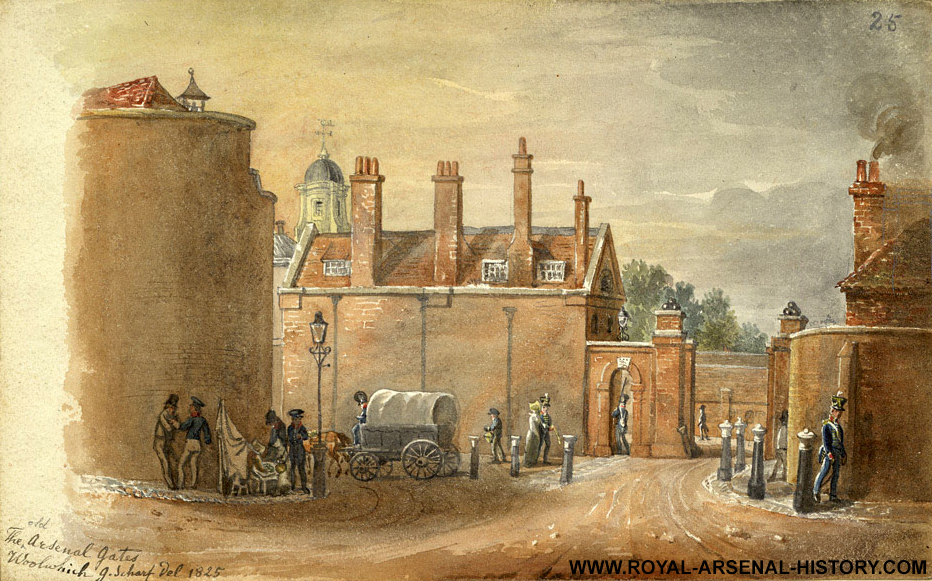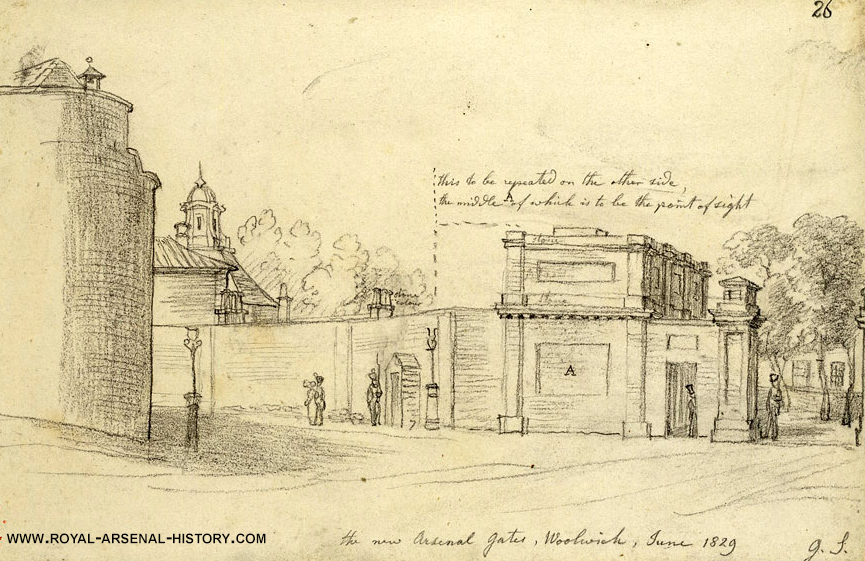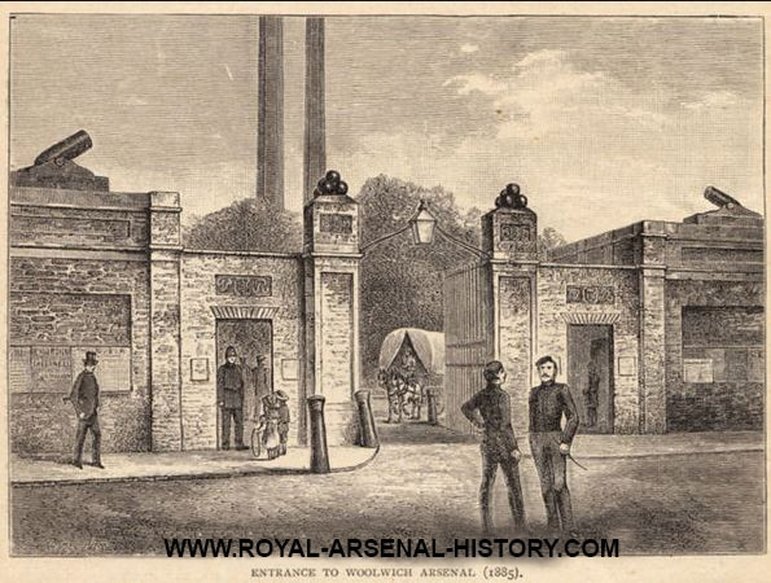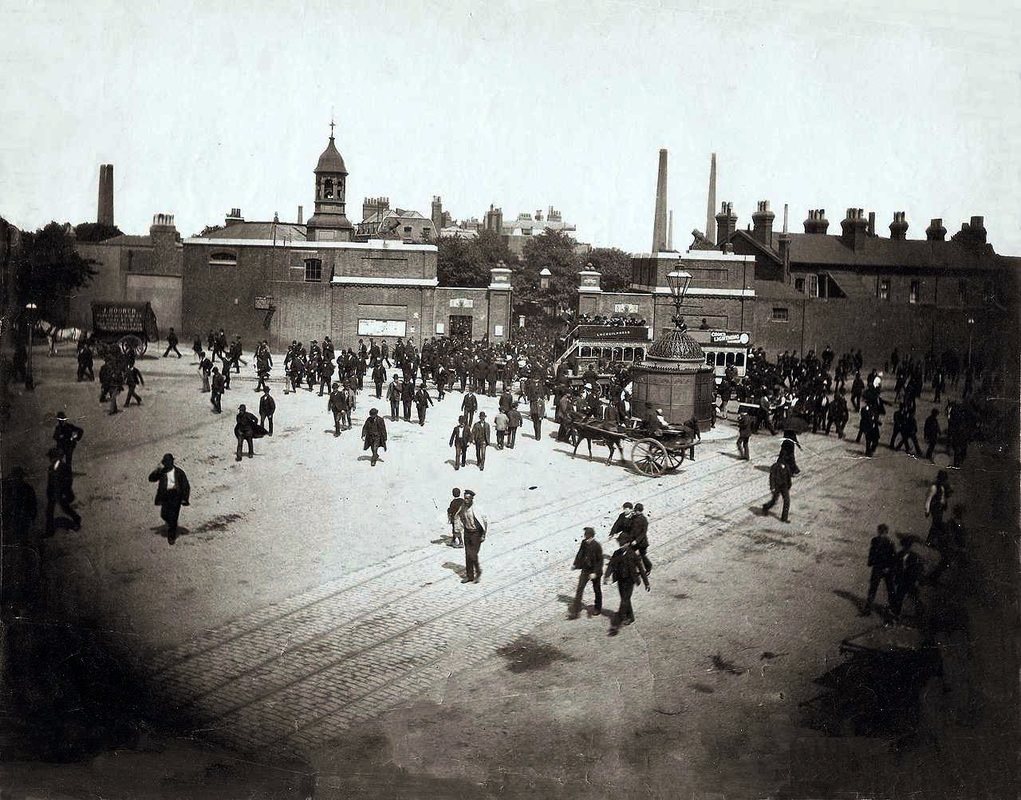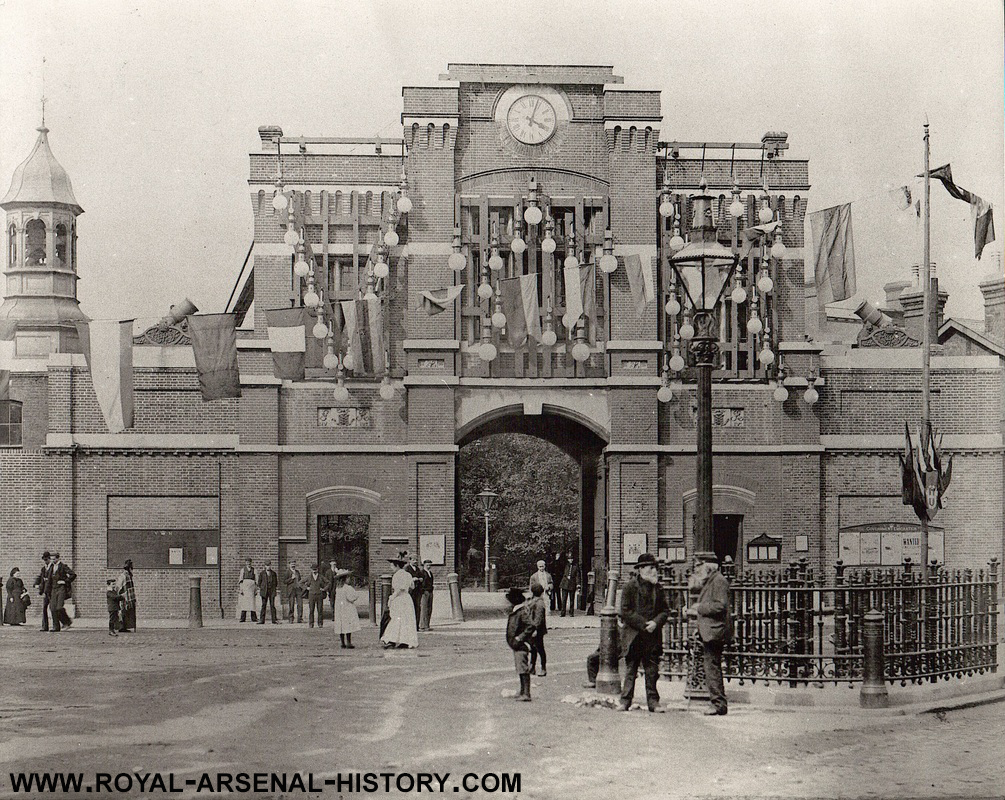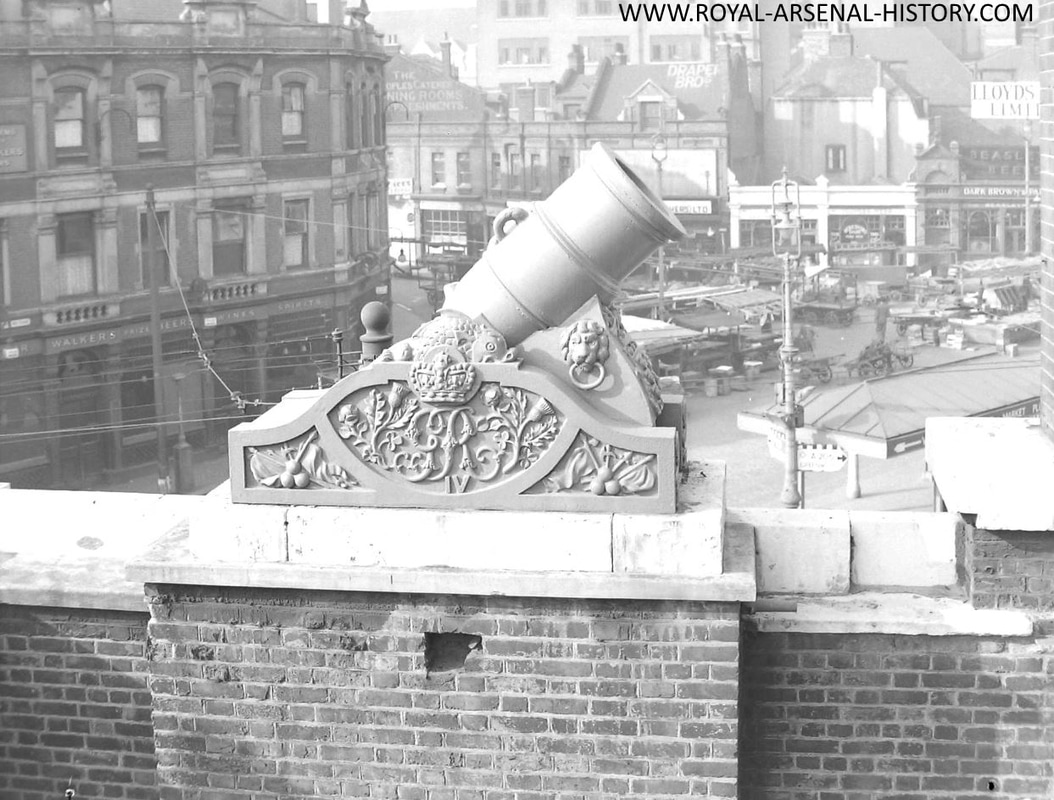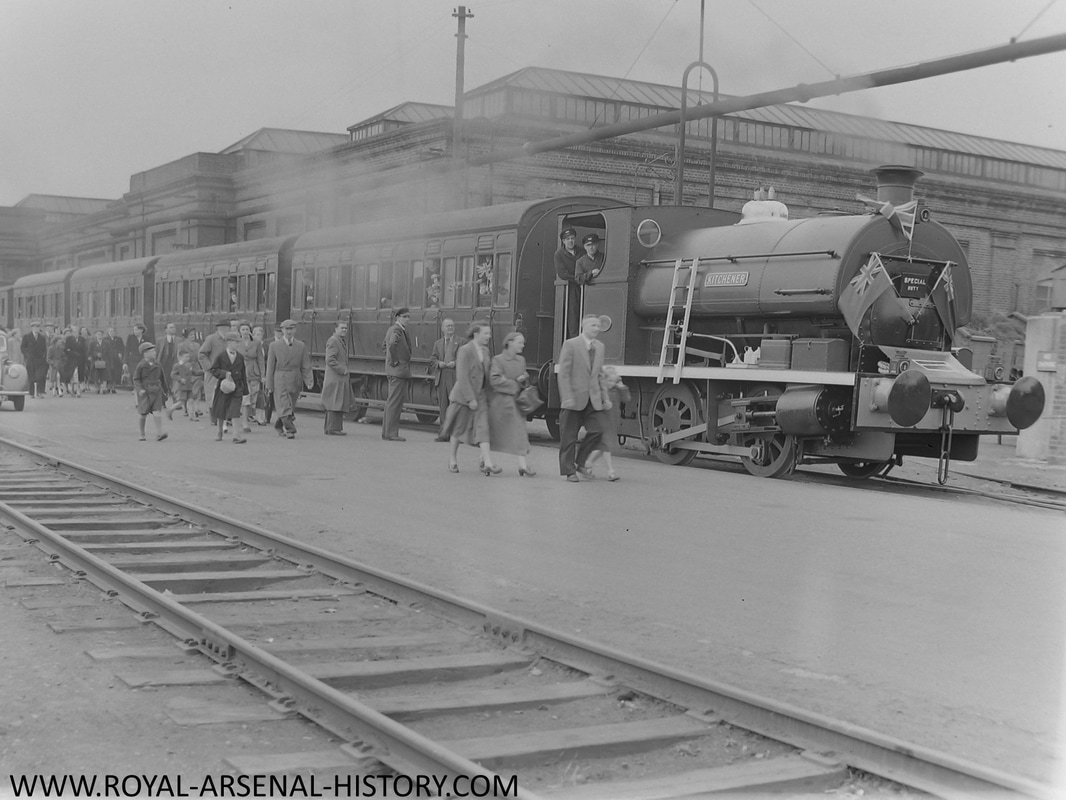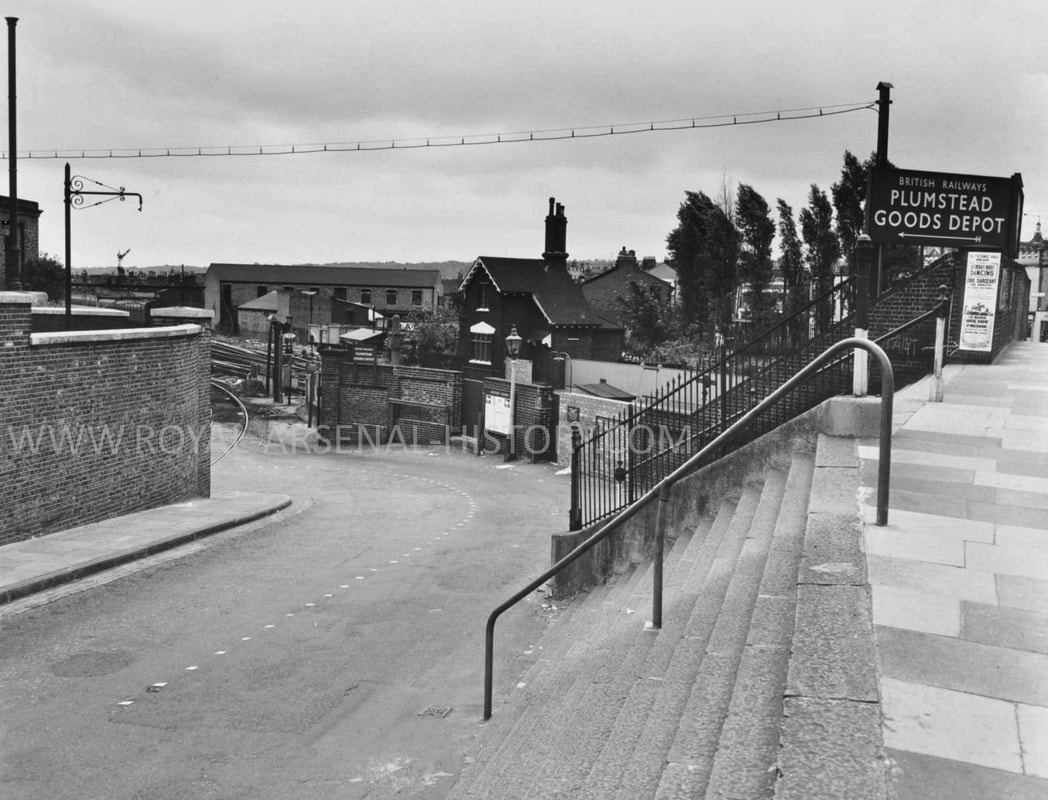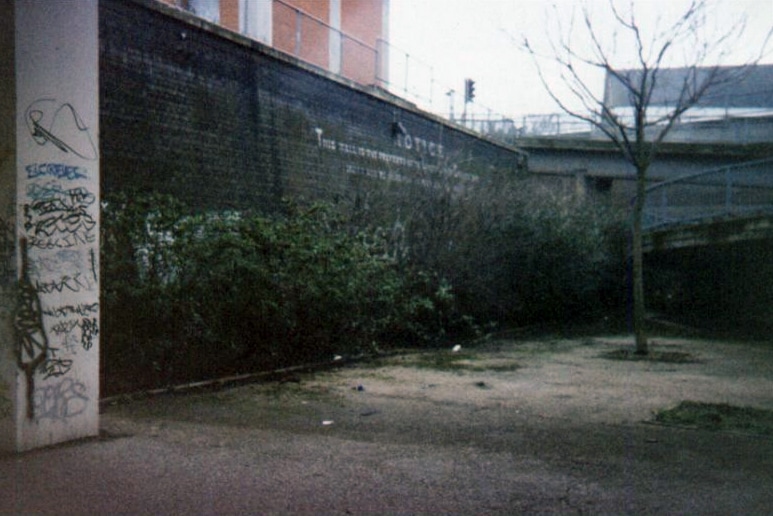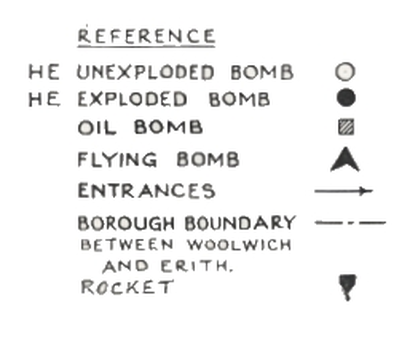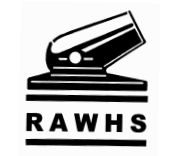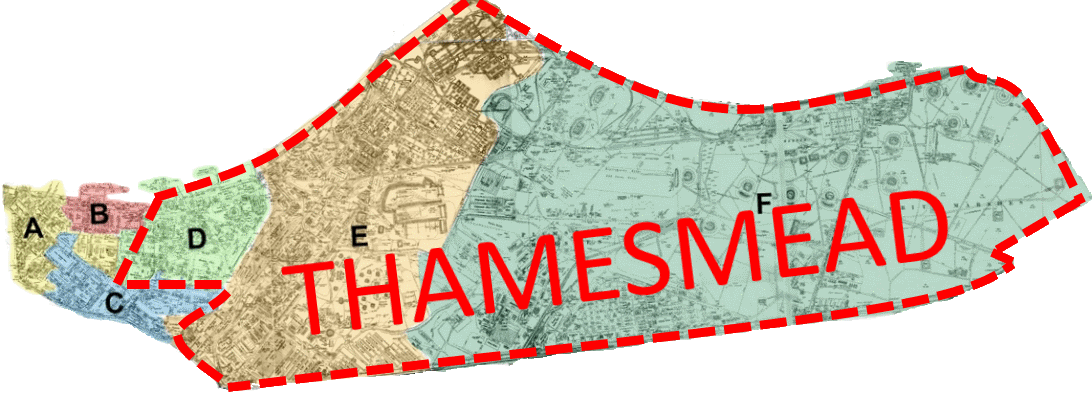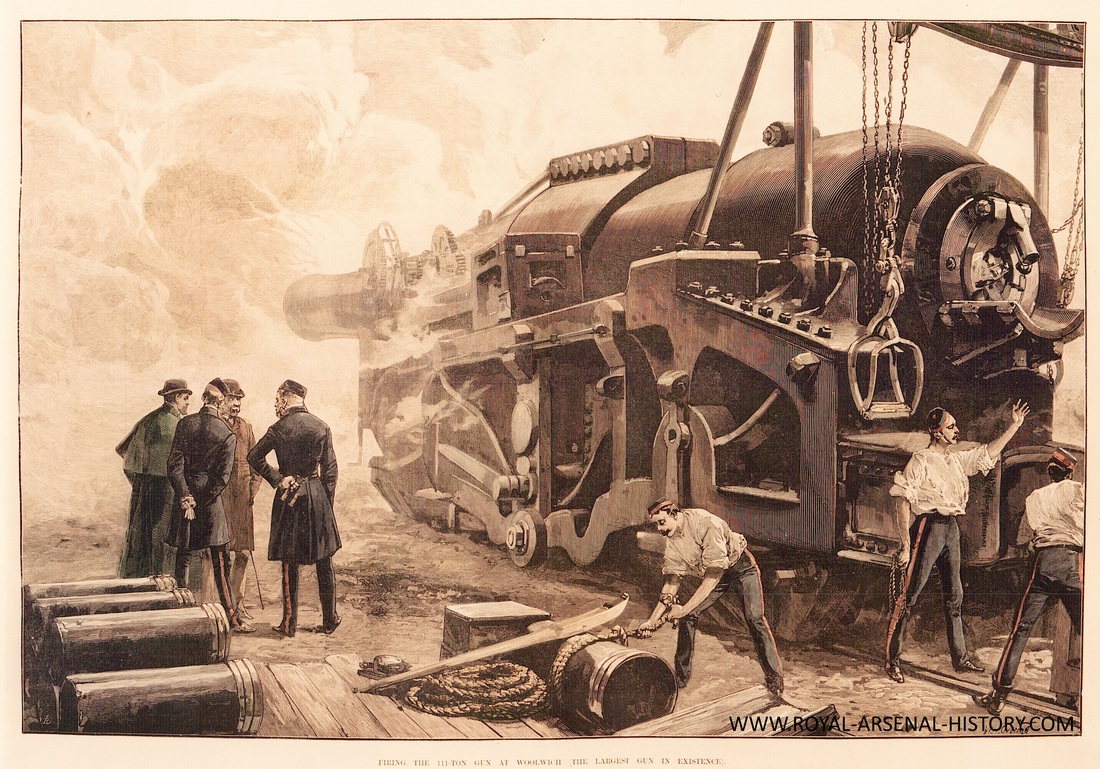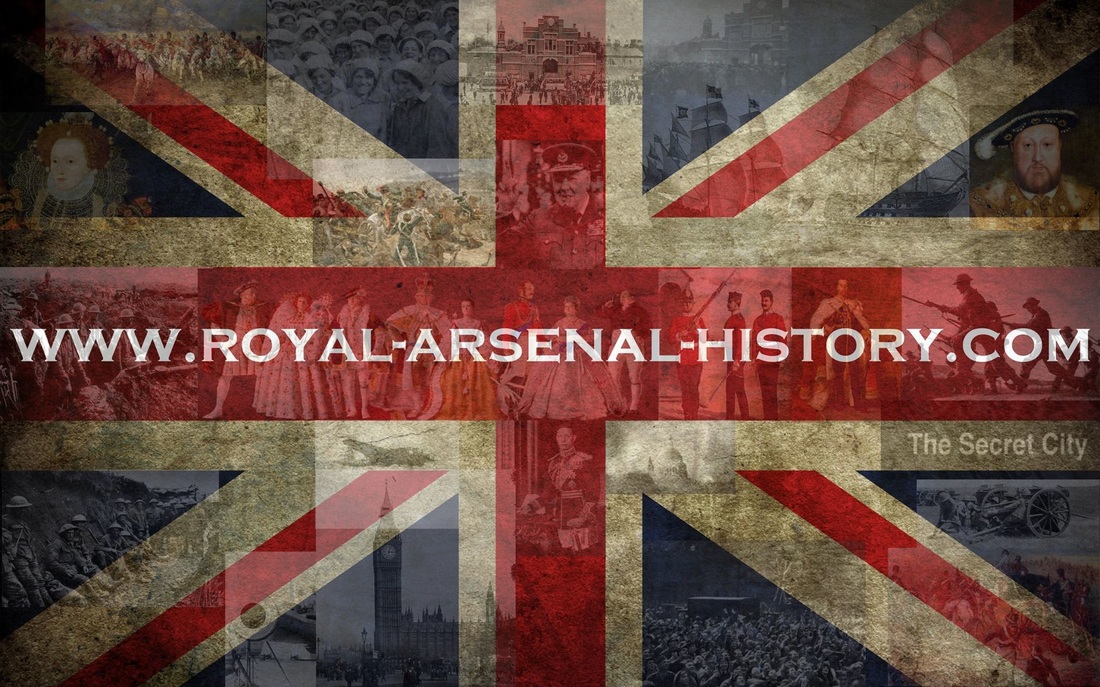The RAH Facebook group and RAH YouTube channel also provide a large volume of information.
|
Next standard RAH tour dates -
Sunday 28th July 2024 | Sunday 11th August 2024 Register interest here Register for a place |
Discover the fascinating past of the Royal Arsenal in Woolwich
Uncover the secrets hidden within its walls. From its humble beginnings to its pivotal role in shaping the course of history, explore the massive scale and intricate inner workings of this historic site. Delve into the many functions it served, from manufacturing weapons and producing large guns and tanks, to supplying ammunition and other armaments for the military in defending the interests of England and the United Kingdom for nearly 500 years.

1945 A.41 Centurion Mk1's.
A recent RAH negative scan. Located outside Royal Arsenal Brass Foundry (Cannon Foundry)
W.D. Index No. T.351700 and T.351701 – The first batch of 100 A.41 tanks made by Royal Ordnance Factory Woolwich ROFW (Royal Arsenal Woolwich)
The Centurion was so successful that it served in the British Army and in numerous other armies across the world from 1945 until the 1990s. The Centurion is still used in South Africa today.
Rare maps, unseen video footage, video presentations, secrets!
On this page you can view and download rare historical maps, watch rare unseen video footage and informative video presentations and uncover hidden gems as you journey through time. Immerse yourself in the rich history of the Royal Arsenal and uncover the secrets that have been hidden for centuries. Trust us, it's worth the wait, even if this webpage takes a while to load!
The Royal Arsenal was 3.5 miles long, 1 mile wide covering 1,300 acres employing 100,000 people at it's peak.
 WW2 Woolwich Royal Arsenal. The Arsenal boundary from Warren Lane to Crossness. The Secret City
WW2 Woolwich Royal Arsenal. The Arsenal boundary from Warren Lane to Crossness. The Secret City
Click the below file to zoom in to the Royal Arsenal and surrounding areas
| master-royal-arsenal-woolwich-map-photo-ww2-1946-1947-rah-zoomable.jpg | |
| File Size: | 25594 kb |
| File Type: | jpg |
RAH tour events of the Royal Arsenal Woolwich 2024.
Standard tour: 3 hours (under 2 miles), register for the next tour in 2024
Next tour date: Sunday 7th July
 Woolwich Arsenal History Standard 3 hour Tour area
Woolwich Arsenal History Standard 3 hour Tour area
The previous standard tours have been exceptionally well-received. We’re certain that you’d enjoy this fully narrated stroll around the historic buildings of what was the largest and most important factory in this Country.
Update: Tours will start from June 2024
If you’d like to participate on a future tour date please let us know via our booking form here or email [email protected]
Your confirmation will guarantee the place(s) you requested as soon as the next tour becomes available.
Extended tour: 6 hours / 5 miles (Includes lunch break on Galleons hill and the standard tour route) The next tour will be in spring 2024.
The tour will be fully narrated, is likely to be over five to six hours long (5 miles) and will feature all the historic buildings in our shorter tours of the Arsenal’s western core. In addition, it will also include the following...
• Full description of how guns were made in the Arsenal from Bronze, Cast Iron, Wrought Iron and Steel.
• Full description of artillery ammunition manufacture.
• A description of high explosives manufacture. Deliberately limited!
• The Arsenal’s canal and it’s recently restored Lock and Swing Bridge.
• The surviving ‘Danger Buildings’.
• The remarkable roll-on roll-off railway slipway for despatch of the largest guns to firing ranges in the Thames Estuary. Its capacity was over 300 tons.
If you’d like to participate please register interest via our booking form here or email [email protected]
Your confirmation will guarantee the place(s) you requested.
• Full description of how guns were made in the Arsenal from Bronze, Cast Iron, Wrought Iron and Steel.
• Full description of artillery ammunition manufacture.
• A description of high explosives manufacture. Deliberately limited!
• The Arsenal’s canal and it’s recently restored Lock and Swing Bridge.
• The surviving ‘Danger Buildings’.
• The remarkable roll-on roll-off railway slipway for despatch of the largest guns to firing ranges in the Thames Estuary. Its capacity was over 300 tons.
If you’d like to participate please register interest via our booking form here or email [email protected]
Your confirmation will guarantee the place(s) you requested.
RAH Tour feedback
Royal Arsenal Woolwich Slideshow
A Secret City, Within a City
Over 120 miles of railway line in 2 square miles, the most complex and densest railway network in British history.
The Royal Arsenal in Woolwich was home to the most complex and densest railway network in British history, with over 120 miles of railway line within just 2 square miles. This extensive network allowed for the efficient transportation of materials and equipment, and enabled the simultaneous operation of multiple manufacturing processes. At its peak, the Arsenal employed up to 100,000 workers, all working together to develop and produce an unparalleled range of military equipment, from small arms to large artillery. This level of industrial activity and the density of railway network is unrivalled in the history of British industry
| royal_arsenal_west_ww2.png | |
| File Size: | 37042 kb |
| File Type: | png |
The main gate of the Royal Arsenal Woolwich
Royal Arsenal Facebook group and YouTube channel.
The Royal Arsenal History Facebook group and YouTube channel are both great resources for those interested in learning more about the history of the Royal Arsenal and local areas.
The Facebook group has thousands of members and provides a platform for sharing and searching for information and research on specific subjects related to the Royal Arsenal. The RAH YouTube channel also offers a wealth of video content and rare photo slideshows.
The Royal Arsenal History Facebook group can be found at this web URL: www.facebook.com/groups/royal.arsenal.history/
The Royal Arsenal History YouTube channel can be found at this web URL: www.youtube.com/@royal-arsenal-history
The Facebook group has thousands of members and provides a platform for sharing and searching for information and research on specific subjects related to the Royal Arsenal. The RAH YouTube channel also offers a wealth of video content and rare photo slideshows.
The Royal Arsenal History Facebook group can be found at this web URL: www.facebook.com/groups/royal.arsenal.history/
The Royal Arsenal History YouTube channel can be found at this web URL: www.youtube.com/@royal-arsenal-history
Woolwich slideshow, Royal Arsenal gatehouse, market, community and more.
Please help RAH with a donation to contribute to the cost of hosting Royal-Arsenal-History website, digital storage and new archival devices. Please see donation options by clicking on the button below or here: Support RAH.
1918 Heroes at Woolwich, WW1 - Men, women, children, elderly and disabled, working in the Royal Arsenal.
Woolwich a Garrison town
Inside the gates of the Royal Arsenal Woolwich
500 Years, a brief history of the Royal Arsenal
Help bring back our local heritage...
PLEASE SIGN HERE via this link chng.it/DkJRdQRg
Urge Greenwich Council to restore a properly functioning archive and museum service.
Urge Greenwich Council to restore a properly functioning archive and museum service.
The Walled Secret City
The Royal Arsenal in Woolwich was known as the Secret City, a mysterious place, surrounded by high brick walls and electric fences, guarded by vigilant Royal Arsenal Police. It was a place of top-secret military operations, where the latest weapons and cutting-edge technology were developed and tested in utmost secrecy. The secrets within those walls were so valuable that they were protected by the secrecy act. It was a like city within a city, a hidden world of espionage and innovation, where only a select few were given access to its secrets.
The Secret City was a hive of industrial activity during World War I. This hidden world was home to a massive workforce of over 82,000 people - made up of 79,500 civilians and 2,500 military staff, an additional 20,000 people were involved in the Arsenal's operations in the surrounding towns, including Charlton, Woolwich, Plumstead, and Abbey Wood.
To accommodate the influx of workers, a temporary railway station was even added between Woolwich and Abbey Wood, accessible through the secretive 5th gate. The arsenal produced a wide range of military equipment, from guns, tanks, and other machinery, to ammunition, shells and other explosive material. It was one of the most vital and important places in the country during the war, playing a critical role in supporting the war effort and keeping the production lines running.
The Royal Arsenal was so secret that even the local residents were unaware of the full scale of production taking place within its walls. But despite the danger, the workers at the Royal Arsenal played a vital role in keeping the nation's defences strong during one of the darkest periods in British history.
The Arsenal was fundamental to a war whose battlefields were dominated by artillery. To keep up with demand the workers would be working from 7am to 7pm, 13 days out of 14 with just the one day off.
The Royal Arsenal was a large, enclosed area located in Woolwich and Plumstead marshes that served as a military manufacturing and storage facility. It consisted of over 1100 buildings, huts, sheds, and other structures, spread out over 1300 acres of land. The production part of the arsenal closed in the late 1960s, and the land was later sold off to the LCC, then the largest Housing Authority in the country.
Today, the land that was once part of the Royal Arsenal is now home to the Woolwich Arsenal Riverside complex and the town of Thamesmead. The history of the Royal Arsenal and its impact on the local community continues to be remembered by those who worked there, had relatives there and some local children. Children explored the remains of many buildings and bunkers and dangerous structures in an overgrown wilderness, without fully understanding the what the arsenal produced. They would bring home bullets, grenades and shells that were not cleared up fully. The buildings that remained were crushed and areas of Thamesmead were covered in sand because of this reason.
Some structures still survive in Thamesmead today and can be seen on this website. A good start would be to see our gazetteer in a few sections down below.
To accommodate the influx of workers, a temporary railway station was even added between Woolwich and Abbey Wood, accessible through the secretive 5th gate. The arsenal produced a wide range of military equipment, from guns, tanks, and other machinery, to ammunition, shells and other explosive material. It was one of the most vital and important places in the country during the war, playing a critical role in supporting the war effort and keeping the production lines running.
The Royal Arsenal was so secret that even the local residents were unaware of the full scale of production taking place within its walls. But despite the danger, the workers at the Royal Arsenal played a vital role in keeping the nation's defences strong during one of the darkest periods in British history.
The Arsenal was fundamental to a war whose battlefields were dominated by artillery. To keep up with demand the workers would be working from 7am to 7pm, 13 days out of 14 with just the one day off.
The Royal Arsenal was a large, enclosed area located in Woolwich and Plumstead marshes that served as a military manufacturing and storage facility. It consisted of over 1100 buildings, huts, sheds, and other structures, spread out over 1300 acres of land. The production part of the arsenal closed in the late 1960s, and the land was later sold off to the LCC, then the largest Housing Authority in the country.
Today, the land that was once part of the Royal Arsenal is now home to the Woolwich Arsenal Riverside complex and the town of Thamesmead. The history of the Royal Arsenal and its impact on the local community continues to be remembered by those who worked there, had relatives there and some local children. Children explored the remains of many buildings and bunkers and dangerous structures in an overgrown wilderness, without fully understanding the what the arsenal produced. They would bring home bullets, grenades and shells that were not cleared up fully. The buildings that remained were crushed and areas of Thamesmead were covered in sand because of this reason.
Some structures still survive in Thamesmead today and can be seen on this website. A good start would be to see our gazetteer in a few sections down below.
Zoomable 1949 Woolwich files below
| 1949-royal-arsenal-woolwich-powis-street-woolwich-high-res-rah-wm.jpg | |
| File Size: | 10319 kb |
| File Type: | jpg |
| 1949-royal-arsenal-woolwich-powis-street-woolwich-rah-high-res-wm-colour.jpg | |
| File Size: | 12867 kb |
| File Type: | jpg |
Royal Arsenal 1918 map zoomed with building numbers and descriptions
Downloadable Secret Maps
See the changes over the years
Download high resolution maps for research here:
| |||||||||||||||||||||||||
| |||||||||||||
1931 Secret Map - Download .pdf high resolution sections below
|
|
| ||||||||||||||||||||||||||||||||||||||||||||||||||||||||||||||||||||||||
Click the below link to download a higher resolution of the above 1918 map, to see what was in your street!
Royal Arsenal 1918 map, Thamesmead overlay with building numbers and descriptions
| royal_arsenal_map_1918___2018_-_copyright_royal-arsenal-history__rah__-_ian_bull_precision_engineering.jpg | |
| File Size: | 8445 kb |
| File Type: | jpg |

Video of Zoomed in WW1 1918 MAP, Thamesmead overlay
1920 Map, Thamesmead overlay
| 1920 vs Today royal_arsenal_1920_overlay_with_2017_map.jpg | |
| File Size: | 12504 kb |
| File Type: | jpg |
 2D 1930s map (Copyright Ian Bull) this map is 3D liftable
2D 1930s map (Copyright Ian Bull) this map is 3D liftable
| 1920_royal_arsenal_woolwich_annotated_map_-_copyright_ian_bull_precision_artwork_02072233572_-_rah.png | |
| File Size: | 19306 kb |
| File Type: | png |
More information on the Departments and Buildings can be found on these pages Departments, Building Numbers & Maps and Buildings & Photos
Arsenal remnants today
Gazetteer of the Arsenal's remnants
| gazetteer_of_the_arsenals_remnants_in_woolwich-thamesmead.txt | |
| File Size: | 31 kb |
| File Type: | txt |
Aerial views of Woolwich and Arsenal in 1985
Why was the Royal Arsenal called 'The Secret City'
The Royal Arsenal was not only hidden from public view, but it was also fully self-contained and self-sufficient. The Arsenal had its own water supply, power generation, housing, and other facilities, which allowed the more than 300 people who lived there to be independent from the outside world. They could live off the produce from their own allotments, chicken runs, and piggeries, as long as the raw materials for the production of weapons were brought in. This level of self-sufficiency made the Royal Arsenal a unique and self-sustaining community within a bustling industrial complex..
The Royal Arsenal had it's own functions like a city:
A gas factory for producing fuel
A power station for generating electricity
Railway network o support transportation of goods and materials
Roads and Canals
Boiler houses to provide heat and power
Timber shops for carpentry and construction
Hospital, Surgery, Dispensary, Mortuary to provide medical care
Fire Stations to protect against fires
Police to maintain law and order and security
Ambulance station to provide emergency medical services
Transport section to move goods and materials around the sit
Shipping and piers including facilities for handling coal
Telephone system for communication
Mail system for sending and receiving letters
Sports association for leisure and recreation
Social club
The piggery (a pub)
Football team
Boundary wall security for security
Catering facilities for food and meals
Paymaster to handle financial transactions
Prison Hulks
and many other services.
Food was another important matter at the Royal Arsenal at Woolwich, as it had to feed a large population of workers and their families. The Arsenal would have had a large number of dining rooms, some of which were located miles away from the main gates, to accommodate the large number of people who lived and worked there. The main butchers shop would have been located near the Hole in the Wall gate. The Arsenal would have had one of the largest industrial catering operations in British history, with an average of 1,500 tons of coal burnt per week to cook food and feed the workforce. The Arsenal would also have had a steady stream of food supplies coming in by ship, with an average of one ship arriving per week.
The Royal Arsenal had it's own functions like a city:
A gas factory for producing fuel
A power station for generating electricity
Railway network o support transportation of goods and materials
Roads and Canals
Boiler houses to provide heat and power
Timber shops for carpentry and construction
Hospital, Surgery, Dispensary, Mortuary to provide medical care
Fire Stations to protect against fires
Police to maintain law and order and security
Ambulance station to provide emergency medical services
Transport section to move goods and materials around the sit
Shipping and piers including facilities for handling coal
Telephone system for communication
Mail system for sending and receiving letters
Sports association for leisure and recreation
Social club
The piggery (a pub)
Football team
Boundary wall security for security
Catering facilities for food and meals
Paymaster to handle financial transactions
Prison Hulks
and many other services.
Food was another important matter at the Royal Arsenal at Woolwich, as it had to feed a large population of workers and their families. The Arsenal would have had a large number of dining rooms, some of which were located miles away from the main gates, to accommodate the large number of people who lived and worked there. The main butchers shop would have been located near the Hole in the Wall gate. The Arsenal would have had one of the largest industrial catering operations in British history, with an average of 1,500 tons of coal burnt per week to cook food and feed the workforce. The Arsenal would also have had a steady stream of food supplies coming in by ship, with an average of one ship arriving per week.
The Workers
The Story
The story of the Arsenal is the story of the growth of the largest military industrial complex in Europe. The story necessarily includes the Dockyard and Ropeyard.
It is not a celebration of warfare, or of the tools of warfare, but one cannot tell the story of a factory by omitting the development of the product.
The Arsenal was never just its buildings. The Arsenal was a tradition of craft and knowledge that passed unbroken from the laying of the first keel to the stamping of the final cartridge. Traditions that spanned some four hundred and fifty years.
The Arsenal shaped the development of Woolwich, Plumstead, Charlton and Eltham. Of national note, and whether good or bad, the Arsenal was also of pivotal importance and at the very heart of the development of the British Empire.
We are telling a story of endeavour, ingenuity, innovation and human industry through the experiences of the ordinary women and men, the military, the craft-masters and the innovators, who together made Woolwich known across the globe.
The Royal Arsenal celebrated its quincentenary in July 2018.
Beginning modestly as the Woolwich Royal Naval Dockyard's unstaffed Gunwharf it became the World's largest manufactory. Its legacy is the survival of this Nation and the establishment of the British Empire. Its part in the defence of the United Kingdom through all its Wars
until the end of the First World War and later cannot be understated. Simply, without the Royal Arsenal we wouldn't be here today.
It is not a celebration of warfare, or of the tools of warfare, but one cannot tell the story of a factory by omitting the development of the product.
The Arsenal was never just its buildings. The Arsenal was a tradition of craft and knowledge that passed unbroken from the laying of the first keel to the stamping of the final cartridge. Traditions that spanned some four hundred and fifty years.
The Arsenal shaped the development of Woolwich, Plumstead, Charlton and Eltham. Of national note, and whether good or bad, the Arsenal was also of pivotal importance and at the very heart of the development of the British Empire.
We are telling a story of endeavour, ingenuity, innovation and human industry through the experiences of the ordinary women and men, the military, the craft-masters and the innovators, who together made Woolwich known across the globe.
The Royal Arsenal celebrated its quincentenary in July 2018.
Beginning modestly as the Woolwich Royal Naval Dockyard's unstaffed Gunwharf it became the World's largest manufactory. Its legacy is the survival of this Nation and the establishment of the British Empire. Its part in the defence of the United Kingdom through all its Wars
until the end of the First World War and later cannot be understated. Simply, without the Royal Arsenal we wouldn't be here today.
The Heart of the British Empire
The Royal Arsenal at Woolwich has a rich and storied history, dating back to the time of Henry VIII, when the Royal dockyards were first built there. Throughout its history, the Arsenal has been closely associated with the production of weapons, including cannons, rifles, and gunpowder. Guns captured by Sir Francis Drake were stored at Woolwich as early as 1586, and 110 years later, the production of arms began at the site. The Royal Arsenal provided ordnance to the Army and Navy throughout the Peninsular and Napoleonic wars and armed Wellington's men for their victories. During the Crimean War, the Royal Arsenal boasted the largest machine shop under one roof, and production was further extended 45 years later to meet the demands of the Boer War. As the British Empire grew, the Arsenal had to keep pace, and for 200 years, its deadly business was hidden from public view by a great stone wall that was two-and-a-half miles long and up to 20ft high, built to prevent espionage
After the Royal Ordnance Factory closed in 1967 and the Arsenal stood spent and forlorn, it was shrouded in secrecy.
After the Royal Ordnance Factory closed in 1967 and the Arsenal stood spent and forlorn, it was shrouded in secrecy.
The Royal Arsenal produced all weapons for Army and Navy. For the most part of 19th and 20th Century, there was little doubt that the most powerful colonial empire of all was the British Empire. British had started their colonial conquest in late 16th century and continued it well into the 20th century. By the year 1922, Britain had colonies on every continent of the world. Britain had dominion over 458 million people which at that time was the one fifth of the global population at that time. Total area under the rule of British was 33,700,000 square kms, approximately a quarter of earths total land area. Such was the prowess of the British empire that it was said that sun never sets in British empire, when one part of the British empire was engulfed in darkness of the night, it would be day in some other British colony.
The Decline
Contraction of the Royal Arsenal began in 1918, land disposals in 1952 and extinguishment came in 1994 yet its innovation and role were vital until the very last moment. Throughout its long drawn-out demise the Royal Arsenal's Whitehall masters paid scant regard to the remarkable heritage within its two square miles. Merely 21 of its 1,100 buildings would be designated for post-military survival and its archive would have been lost entirely without the efforts of concerned employees.
The losses continue and public awareness of the utter vitality of the Arsenal is rapidly evaporating. Only in 2016 the last large factory building was swept-away without a murmur. The bodies that might be expected to campaign for retention of historic structures and conservation of historic records appear to be concerned only in 'footfall' and 'retail opportunity'.
The losses continue and public awareness of the utter vitality of the Arsenal is rapidly evaporating. Only in 2016 the last large factory building was swept-away without a murmur. The bodies that might be expected to campaign for retention of historic structures and conservation of historic records appear to be concerned only in 'footfall' and 'retail opportunity'.
A new town, Thamesmead is born
The site was finally closed in 1967, and the land was later developed into a new town, Thamesmead. The closure and sale of the land made it possible for the government to develop a new town, providing much-needed housing and community facilities for Londoners. Without the decline and closure of the Royal Arsenal, the land would not have been available for development, and Thamesmead would not exist today.
A Royal Arsenal introduction with pictures, videos and documents
The Royal Arsenal began in July 1518 when a small plot by the Thames in Woolwich was purchased for the equipping with Ordnance of newly constructed warships. This 'Gunwharf' was outgrown by 1670 and the Crown obtained the almost adjacent estate known as Tower Place or the Woolwich Warren who's land was already being rented-out for the 'proofing' of artillery
By 1696 specialised buildings had been constructed on the new site for the blending and testing of Gunpowder and the finishing of cannon balls. By 1700 this new 'Woolwich Arsenal' was the most important armaments facility in England. The manufacture of guns commenced in 1720 and began an engineering odyssey. Granted the title 'Royal Arsenal' in 1805 the establishment's growth mirrored that of the British Empire until by the early 20th Century it was over three miles long and covered two square miles. The site doubled in size between 1892 and 1907 alone yet the ever increasing range of guns had already rendered Woolwich inadequate and the Arsenal had spawned the extensive firing ranges at Shoeburyness in 1845.
The area had great military and naval importance. In 1515 Henry VIII (r.1509 – 1547) ordered the building of the warship Henri Grace à Dieu as part of an effort to improve and enlarge the English Navy and to this end established a major dockyard at Woolwich, very close to the area now occupied by Thamesmead. It was from this point onwards that the area became an important naval and military centre. The Thamesmead site, mostly on the Greenwich side of the boundary, was used for storing ordnance or ammunition from as early as 1565 and gradually more and more land was given over to what became the Royal Arsenal. This institution made and tested guns and ammunition.
The land was ideal for this purpose, as there were still very few people living in the area. In addition the marshy ground deadened the impact of explosions and therefore was safer when testing ammunition. One of the weapons tested on the marshes near Plumstead was called Mallet’s Mortar. It was meant to be portable but ended up weighing 42 tons! Mallet’s Mortar was not a successful invention – on its first test firing in October 1857 a fracture appeared in the metal and the project was abandoned.
The Royal Arsenal brought much-needed trade to the area as people employed in the munitions factories came to live in the nearby towns and villages. The area became more and more important militarily throughout the 18th and 19th centuries – England was at war with many countries, including France and Spain. The Crimean War of 1854 – 56 placed big demands on the Arsenal.
The First World War saw the zenith with some 80,000 employed within the walls, a further 20,000 in the surrounding neighbourhood and the creation of dozens of subsidiary ammunition plants staffed by hundreds of thousands across Great Britain. Whilst the Great War was the zenith it also marked the beginning of the end. The Arsenal was far enough up-river to be immune from Naval bombardment but from 1915 such immunity vanished with the onset of bombardment from the air. The Arsenal was well within the range of German aircraft and its river-side location made for an easily identifiable target.
Partly because of isolated Zeppelin raids on the Arsenal during the First World War, officials became worried about the manufacture and testing of guns and ammunition so close to densely populated areas. The Arsenal was now surrounded by residential developments as London expanded further and further outwards. Therefore from the 1920s onwards the site was scaled down. Both the testing and manufacture of weapons were moved to more remote and secret areas.
The Second World War merely confirmed the need to move the Arsenal elsewhere. Its location was well known and it was easily visible, with the result that the Luftwaffe could target it for bombing raids – and this meant that surrounding residential areas were also badly damaged.
Closure was discussed at the end of the First World War and firm proposals were drawn-up for a move to sites either side of the Severn Estuary in 1936. A workforce resistant to re-location and the prospect of another war with Germany saw Woolwich survive.
The Arsenal was heavily re-equipped in the Second World War and its functions complimented by dozens of new Royal Ordnance Factories spread across the Country. All were numbered, the Royal Arsenal being ROF No. 1. The post-war years brought Woolwich an Indian summer bolstered somewhat by the Korean War. The late 1940s saw the Arsenal design and manufacture the UK's first Atomic Bomb and whilst the heaviest Naval guns became obsolete in the early 1950s their production was replaced with the construction of hundreds of Tanks. Considerable quantities of ammunition continued to be handled and the design and manufacture of Artillery remained largely in Arsenal hands, yet the writing remained on the wall.
Land disposals began in 1952 and a large sale occurred in 1955. The London County Council were handed the Eastern 60% of the site in 1962 for housing development following the cessation of ammunition production. Closure was recommended in a Government report of 1962 and manufacturing ceased in 1967. The Royal Ordnance Factories and private industry were able to accept the workload but the town of Woolwich found it very difficult to absorb the 6,700 redundancies. Further disposals took place in the late 1960s leaving the Arsenal divided into to separate sections, East and West. Royal Arsenal West concentrated on the testing of military equipment whilst Royal Arsenal East specialised in Research and Development. Notable anti-terrorist work was carried-out in the Eastern section.
Both Royal Arsenal West and East closed in 1994 with much of the Eastern section's work transferred to the Arsenal's out-station at Fort Halstead near Sevenoaks.
The area had great military and naval importance. In 1515 Henry VIII (r.1509 – 1547) ordered the building of the warship Henri Grace à Dieu as part of an effort to improve and enlarge the English Navy and to this end established a major dockyard at Woolwich, very close to the area now occupied by Thamesmead. It was from this point onwards that the area became an important naval and military centre. The Thamesmead site, mostly on the Greenwich side of the boundary, was used for storing ordnance or ammunition from as early as 1565 and gradually more and more land was given over to what became the Royal Arsenal. This institution made and tested guns and ammunition.
The land was ideal for this purpose, as there were still very few people living in the area. In addition the marshy ground deadened the impact of explosions and therefore was safer when testing ammunition. One of the weapons tested on the marshes near Plumstead was called Mallet’s Mortar. It was meant to be portable but ended up weighing 42 tons! Mallet’s Mortar was not a successful invention – on its first test firing in October 1857 a fracture appeared in the metal and the project was abandoned.
The Royal Arsenal brought much-needed trade to the area as people employed in the munitions factories came to live in the nearby towns and villages. The area became more and more important militarily throughout the 18th and 19th centuries – England was at war with many countries, including France and Spain. The Crimean War of 1854 – 56 placed big demands on the Arsenal.
The First World War saw the zenith with some 80,000 employed within the walls, a further 20,000 in the surrounding neighbourhood and the creation of dozens of subsidiary ammunition plants staffed by hundreds of thousands across Great Britain. Whilst the Great War was the zenith it also marked the beginning of the end. The Arsenal was far enough up-river to be immune from Naval bombardment but from 1915 such immunity vanished with the onset of bombardment from the air. The Arsenal was well within the range of German aircraft and its river-side location made for an easily identifiable target.
Partly because of isolated Zeppelin raids on the Arsenal during the First World War, officials became worried about the manufacture and testing of guns and ammunition so close to densely populated areas. The Arsenal was now surrounded by residential developments as London expanded further and further outwards. Therefore from the 1920s onwards the site was scaled down. Both the testing and manufacture of weapons were moved to more remote and secret areas.
The Second World War merely confirmed the need to move the Arsenal elsewhere. Its location was well known and it was easily visible, with the result that the Luftwaffe could target it for bombing raids – and this meant that surrounding residential areas were also badly damaged.
Closure was discussed at the end of the First World War and firm proposals were drawn-up for a move to sites either side of the Severn Estuary in 1936. A workforce resistant to re-location and the prospect of another war with Germany saw Woolwich survive.
The Arsenal was heavily re-equipped in the Second World War and its functions complimented by dozens of new Royal Ordnance Factories spread across the Country. All were numbered, the Royal Arsenal being ROF No. 1. The post-war years brought Woolwich an Indian summer bolstered somewhat by the Korean War. The late 1940s saw the Arsenal design and manufacture the UK's first Atomic Bomb and whilst the heaviest Naval guns became obsolete in the early 1950s their production was replaced with the construction of hundreds of Tanks. Considerable quantities of ammunition continued to be handled and the design and manufacture of Artillery remained largely in Arsenal hands, yet the writing remained on the wall.
Land disposals began in 1952 and a large sale occurred in 1955. The London County Council were handed the Eastern 60% of the site in 1962 for housing development following the cessation of ammunition production. Closure was recommended in a Government report of 1962 and manufacturing ceased in 1967. The Royal Ordnance Factories and private industry were able to accept the workload but the town of Woolwich found it very difficult to absorb the 6,700 redundancies. Further disposals took place in the late 1960s leaving the Arsenal divided into to separate sections, East and West. Royal Arsenal West concentrated on the testing of military equipment whilst Royal Arsenal East specialised in Research and Development. Notable anti-terrorist work was carried-out in the Eastern section.
Both Royal Arsenal West and East closed in 1994 with much of the Eastern section's work transferred to the Arsenal's out-station at Fort Halstead near Sevenoaks.
Royal Laboratory 1696
The complex was renamed the Royal Arsenal in 1805, following a suggestion by King George III
The secret walled City
Royal Arsenal market and inside the main gate
WOOLWICH MARKET over 100 years ago during WWI in 1918 and a glimpse INSIDE the Royal Arsenal gates.
Royal Arsenal market 1981
1981 Woolwich market area and Royal Arsenal gatehouse
Royal Arsenal gates
Royal Arsenal main gate 1 - Beresford Square
Development of the Arsenal gate in Beresford Square, from 1829 thought the various alterations up to the widening of the two pedestrian gates in 1935, the Gatehouse is still here today.
Included below is a picture from 1825 of the previous gate.
The new, wider, gate was placed to the West of the original and formed part of the straightening of the Arsenal wall with a drawing, by the same artist, of half of the new gate. His notes show that the other half is a mirror image to complete the picture of the new 1829 gate.
Included below is a picture from 1825 of the previous gate.
The new, wider, gate was placed to the West of the original and formed part of the straightening of the Arsenal wall with a drawing, by the same artist, of half of the new gate. His notes show that the other half is a mirror image to complete the picture of the new 1829 gate.
The original Main Gate to the Arsenal was sited adjacent to the Main Guard House, but in 1829 on the order of Lord Beresford a new gate was erected; this gate is the lower part of the present edifice.
The Bell Tower was added in 1859 and the superstructure over the gateway in 1891. The single side gates were converted to double gates in 1935. The inscription recording the building of the gateway can be seen on the stairway at the West side of the gate.
The left and right pedestrian gates were widened in 1935 as per this drawing.
The bronze models of mortars bear the monogram of George IV.
Gate 2 Middlegate house
Gate 3 Plumstead Road (Marsh gate)
Gate 3 - Open to public to see the Queen on the Thames
Gate 4 - Plumstead Bridge gate 4 (Hole in the wall)
Photo taken in the 1990's
Church Manor way (gate 5)
- Please send in photo if you have one
Plumstead marshes (Thamesmead) Harrow Manor Way (gate 6)
Today this is the known as the "A" Bridge area / Elevated round about / Carlyle Road. Harrow Manor Way path will still take you to the River Thames.
Royal Arsenal Historical Notice Board
Inside the Royal Arsenal - ex.Greenwich heritage centre museum
This exhibition told the fascinating story of the Royal Arsenal and the Royal Woolwich Dockyard by looking across 400 years of history from Henry VIII to modern times. The exhibition is hands-on allowing the visitor to see and hear aspects of the Arsenals history and to look at objects relating to the site and its activities. (The exhibition no longer displayed and the Heritage centre has moved away from Woolwich)
1914 -1918 Royal Arsenal 1.5 hour video footage
Roy Masters Audio Snippet 1993
Life in the Royal Arsenal - Full Roy Masters audio tape link here
Royal Woolwich Arsenal has been in production since 1670, producing all the weapons needed for Army and Navy from King Henry VIII times.
The English were the most aggressive war like people in the history of time and built up the biggest empire ever and the biggest empire that ever will be. More here
The English were the most aggressive war like people in the history of time and built up the biggest empire ever and the biggest empire that ever will be. More here
The early origins of the Royal Arsenal lie with the creation of a dockyard in Woolwich by Henry VIII. The yard, located just to the east of the present ferry terminal was originally built for the construction of 'The Great Harry'. Land further east of the yard, known as 'The Warren' was used for testing guns and a gun wharf constructed in 1546.
When you consider the early history of the Royal Arsenal at Woolwich the armaments production started on site at the Woolwich Warren in about 1696. This involved the manufacture of Fireworks and Explosive Ammunition. There was already on site a proof butt, used at contractor's own expense to proof guns/barrels for supply to the navy etc. Progressively the Warren site developed to include Gun and Carriage production and by 1805 the King decided that overall activity warranted a name change to the Royal Arsenal. Not only a place of manufacture but also a national arms store.
In the later decades of the nineteenth century the Royal Arsenal was among the world’s largest depots for army stores, and an arms factory without parallel. It deployed the heaviest and most sophisticated machine tools invented, to devastating effect on many distant parts of the world
The Arsenal shaped the development of Woolwich, Plumstead, Charlton and Eltham. Of national note, and whether good or bad, the Arsenal was also of pivotal importance and at the very heart of the development of the British Empire.
The story of the Arsenal is the story of the growth of the largest military-industrial complex in Europe. This website reflects a very small fraction of the history of the Royal Arsenal.
See the Royal Arsenal timeline here.
In the later decades of the nineteenth century the Royal Arsenal was among the world’s largest depots for army stores, and an arms factory without parallel. It deployed the heaviest and most sophisticated machine tools invented, to devastating effect on many distant parts of the world
The Arsenal shaped the development of Woolwich, Plumstead, Charlton and Eltham. Of national note, and whether good or bad, the Arsenal was also of pivotal importance and at the very heart of the development of the British Empire.
The story of the Arsenal is the story of the growth of the largest military-industrial complex in Europe. This website reflects a very small fraction of the history of the Royal Arsenal.
See the Royal Arsenal timeline here.
Royal Arsenal documents, publications
1899 - Ordnance Factories Woolwich. Army and Navy illustrated
Document credit: John Balding
Ordnance Factories_Woolwich 1899.pdf
Ordnance Factories_Woolwich 1899.pdf
Your browser does not support viewing this document. Click here to download the document.
1898 - Army and Navy illustrated - the news
Your browser does not support viewing this document. Click here to download the document.
| navy___army_-_the_news_1898_rah.pdf | |
| File Size: | 76709 kb |
| File Type: | |
The Royal Arsenal - Buildings
Your browser does not support viewing this document. Click here to download the document.
The Royal Arsenal - UCL.AC.UK
Your browser does not support viewing this document. Click here to download the document.
Bombs away! September 1940 and the Blitz.
Below: German bombers over Thamesmead photographed by the Luftwaffe showing Dorniers over Erith Marshes/Royal Arsenal dates from 1940, September 7th 1940 was the day that the London blitz started with Woolwich, the Docks, Silvertown, etc all being heavily bombed. The Dornier Do 17, sometimes referred to as the Fliegender Bleistift or 'flying pencil', was a WW2 bomber intended to be light enough to outrun defending fighter aircraft. More information here
On September 7th 1940, 348 German bombers escorted by 617 fighters attacked the capital in the late afternoon, forming a 32-km (20-mile)-wide block of aircraft filling more than 2000 square kilometres (800 square miles) of sky.
The attack took the British by surprise. The Germans concentrated their attack on London’s Docklands and met little resistance that day causing huge destruction to London’s east end.
After this London was bombed at night almost every night until May 10th 1941. The East End took the worst of it, due to the industrial targets along the docks and river Lea.
The attack took the British by surprise. The Germans concentrated their attack on London’s Docklands and met little resistance that day causing huge destruction to London’s east end.
After this London was bombed at night almost every night until May 10th 1941. The East End took the worst of it, due to the industrial targets along the docks and river Lea.
Bombs Dropped and recorded before 1973
BBC London live - Woolwich Arsenal History
Listen to BBC London live broadcast about Woolwich Arsenal History. Arsenal football club?
Woolwich Royal Arsenal during WWI. 100 years on.
Ian Bull presents the Royal Arsenal "Then and Now"
Presentation on the Royal Arsenal East to West, buildings then and now and the original plans for Thamesmead and much more. Part 1 Thamesmead, Part 2 Woolwich.
A206 Plumstead road cut through in front of Royal Arsenal Gatehouse, Rare aerial photo's (1987)
Royal Arsenal Woolwich 1996 - After Closure
Royal Arsenal East
Behind closed doors
Architecture and decline
Archaeology
The Royal Arsenal today
Royal Arsenal Woolwich Historical Society (RAWHS)
By the mid 1980's it was becoming clear to the Arsenal's staff that closure was looming and that the Ministry of Defence had little intention of preserving anything from the site which had defended the Nation for four and a half Centuries. Concerned employees formed the Royal Arsenal Woolwich Historical Society (RAWHS) and set about ensuring the preservation of some two shipping container loads of artefacts and records. Also known as the Royal Arsenal Association up until closure in 2017.
Royal Arsenal East - A page for the secret history of Thamesmead
Click on the button below to go to the Thamesmead related Royal Arsenal page.
Photo: Thamesmead Firing range (Royal Arsenal East)
This Royal Arsenal History Website
The purpose of this website is to provide an in-depth look at the Royal Arsenal at Woolwich in South East London, which was one of the most significant industrial complexes in British history and in world history. The website aims to research and document as much information as possible about the Arsenal, which played a crucial role in defending the interests of England and the United Kingdom for nearly 500 years. Through its expertise and output, the royal arsenal enabled the UK to build an empire that encompassed a quarter of the world's population and helped the nation and empire survive through two World Wars. Given that much of the history of the arsenal was secret, the website aims to unearth and capture as much information as possible about this important historical site. Additionally, it is important to note that preserving the history of the Royal Arsenal at Woolwich is crucial, as it serves as a reminder of the role it played in shaping the country's and the world's history, and it is a valuable resource for educating future generations about this important historical site. More details here
If you would like to discuss Royal Arsenal History please feel free to join the below Facebook group or visit the blog page here
Royal Arsenal 3D model to capture history
RAH has an ambitious goal of creating a 3D model of the entire Arsenal site to bring the Royal Arsenal to life using the information gathered from the website and also from the RAH Facebook group and RAH rare archives, these include, video archives, maps, photos and aerial photos unseen by the public. This model will enable users to have a virtual reality experience, including walk or fly through scenarios, and potentially integrate the model into mainstream computer games. This is a unique and innovative project that has the potential to greatly enhance the understanding and appreciation of the Arsenal site. The RAH team hopes to consult with developers to bring this to realisation. Contact us here
Upload Royal Arsenal History here
Please browse around the various menus and sub menus for more detailed information about the Royal Arsenal. Add your own history, research and photos by contributing via comment's or upload buttons.








